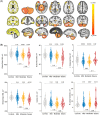Serum NfL and GFAP as biomarkers of progressive neurodegeneration in TBI
- PMID: 38805359
- PMCID: PMC11247683
- DOI: 10.1002/alz.13898
Serum NfL and GFAP as biomarkers of progressive neurodegeneration in TBI
Abstract
Background: We examined spatial patterns of brain atrophy after mild, moderate, and severe traumatic brain injury (TBI), the relationship between progression of brain atrophy with initial traumatic axonal injury (TAI), cognitive outcome, and with serum biomarkers of brain injury.
Methods: A total of 143 patients with TBI and 43 controls were studied cross-sectionally and longitudinally up to 5 years with multiple assessments, which included brain magnetic resonance imaging, cognitive testing, and serum biomarkers.
Results: TBI patients showed progressive volume loss regardless of injury severity over several years, and TAI was independently associated with accelerated brain atrophy. Cognitive performance improved over time. Higher baseline serum neurofilament light (NfL) and glial fibrillary acidic protein (GFAP) were associated with greater rate of brain atrophy over 5 years.
Discusssion: Spatial patterns of atrophy differ by injury severity and TAI is associated with the progression of brain atrophy. Serum NfL and GFAP show promise as non-invasive prognostic biomarkers of progressive neurodegeneration in TBI.
Highlights: In this longitudinal study of patient with mild, moderate, and severe traumatic brain injury (TBI) who were assessed with paired magnetic resonance imaging (MRI), blood biomarkers, and cognitive assessments, we found that brain atrophy after TBI is progressive and continues for many years even after a mild head trauma without signs of brain injury on conventional MRI. We found that spatial pattern of brain atrophy differs between mild, moderate, and severe TBI, where in patients with mild TBI , atrophy is mainly seen in the gray matter, while in those with moderate to severe brain injury atrophy is predominantly seen in the subcortical gray matter and whiter matter. Cognitive performance improves over time after a TBI. Serum measures of neurofilament light or glial fibrillary acidic protein are associated with progression of brain atrophy after TBI.
Keywords: brain volume; glial fibrillary acidic protein; neurofilament light; tau; traumatic brain injury; ubiquitin C‐terminal hydrolase‐L1.
Published 2024. This article is a U.S. Government work and is in the public domain in the USA. Alzheimer's & Dementia published by Wiley Periodicals LLC on behalf of Alzheimer's Association.
Conflict of interest statement
The authors declare no conflicts of interest. Author disclosures are available in the supporting information.
Figures






References
-
- Smith DH, Chen XH, Pierce JE, et al. Progressive atrophy and neuron death for one year following brain trauma in the rat. J Neurotrauma. 1997;14:715‐727. - PubMed
-
- Ross DE. Review of longitudinal studies of MRI brain volumetry in patients with traumatic brain injury. Brain Inj. 2011;25:1271‐1278. - PubMed
Publication types
MeSH terms
Substances
Grants and funding
LinkOut - more resources
Full Text Sources
Medical
Miscellaneous

